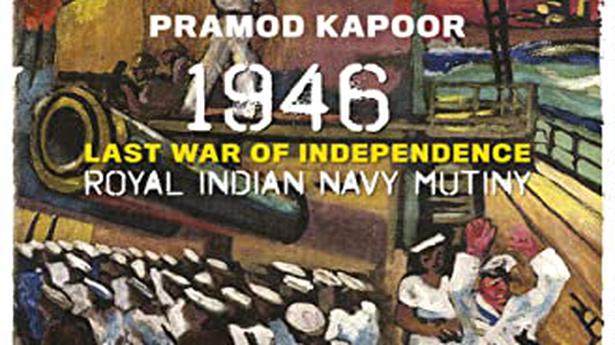Pramod Kapoor turns a footnote in history into a remarkable account of a rebellion that convinced the British it was time to leave India
Pramod Kapoor turns a footnote in history into a remarkable account of a rebellion that convinced the British it was time to leave India
As Shyam Benegal has rightly pointed out, a footnote in the history of the liberation movement has turned into a compelling and important narrative in Pramod Kapoor’s book. 1946 Last War of Independence: Royal Indian Navy mutiny. Pramod himself came across this forgotten story while researching his book on Gandhi: “Once the draft of Gandhi’s book was finished, I re-read the episodes of mutiny in the Royal Indian Navy and I I realized the magnitude of the event.”
Reports of the revolt
When Pramod began his research, he discovered hundreds of reports from British admirals, commanders of ships and establishments ashore, cables and letters exchanged between London and Delhi, debates in the British parliament and debates in the Legislative Council in India. They were “honest”, but were told from a British perspective. For another perspective, Pramod skimmed through hundreds of newspaper articles and library documents, met people with knowledge of the revolt, and visited HMIS Talwar, the Navy Signals School in Colaba, where ” inflammatory slogans” had been written on the walls and “seditious pamphlets” circulated. A tour of the Navy Nagar shipyard and areas in Mumbai helped him understand “the history and geography of the region where the uprising took place”.
In February 1946, the ratings, or the lowest echelon of sailors in the hierarchy of the Royal Indian Navy, staged a revolt. The young sailors protested that the promises made at the time of recruitment had not been kept: the living conditions were horrible; the food was worse and there was rampant racial discrimination. Also, says Pramod, inspired by the Indian National Army (INA), they were politically charged and eager to play a role in India’s freedom movement. Within 48 hours, the number of mutineers grew to 20,000 and they took control of ships afloat and establishments ashore. Army and Air Force personnel as well as civilians joined the protests.
Sailors pulled down Royal Navy White Ensigns and hoisted three flags – the Congress tricolour, the Muslim League green and the Communist Party red, Pramod writes. Their demands included the release of all Indian political prisoners and soldiers who had fought in the Azad Hind Fauj. There was a direct link, says Pramod, to the INA trials that were taking place at the time. Within days, the British put down the rebellion with a “combination of brute force and cunning”.
Pitched battles took place in Bombay and Karachi as the British attempted to regain control of ships and naval establishments from sailors. The Indian soldiers were reluctant to open fire on their compatriots. So, Pramod argues, although the rebellion was put down, the British realized it was time to leave India.
For Pramod, however, the politicians haven’t exactly covered themselves in glory. “They actually helped the British end the uprising, despite widespread sympathy for the ratings across the country.”
The promises made by the Indian leaders to the sailors at the time of the surrender have not been kept, he underlines. Pramod also strongly believed that Partition “would have been less bloody had political leaders tried to build on the communal unity created by the events of February 1946 instead of ignoring it.” This was also the view of the incendiary socialist and freedom fighter Aruna Asaf Ali. Even after independence, efforts were made to “erase the memory of the mutiny”, so much so that Bengali comedian Utpal Dutt’s fictional play based on it, Kalolol (Concussion), faced “obstruction and unofficial censorship”.
Before the demonstration
On the eve of the uprising, the British were conducting the public trial of three INA army officers – Prem Kumar Sahgal, Shahnawaz Khan and Gurbaksh Singh Dhillon. “Having a Hindu, a Muslim and a Sikh jointly tried in the Red Fort at a time when most Indians were deeply sympathetic to the INA meant that three major communities stood united behind the call for independence,” writes Pramod. .
But congressional leaders were of the view that their idea of a peaceful outcome of a struggle for freedom and a smooth transfer of power would have been lost if an armed revolt succeeded with undesirable consequences. Thus, it was not an easy situation for political leaders to close ranks with the audiences.
Pramod has done a commendable job of addressing all aspects of the rebellion. In the chapter entitled “The Gathering Storm”, Pramod recounts the genesis and warnings of the coming revolt. There was anger and resentment about the unfair treatment of INA officers by the British, particularly at the signals school at HMIS Talwar, where the sailors were from better academic backgrounds and aware of “rebellious activity that unfolded beyond the high walls of their barracks”. One of the villains was surely Commander Arthur Frederick King whose rude behavior and “crass and racist language” sparked the protest at HMIS Talwar. As Talwar was the center of all communications, the spark quickly turned to fire as the strike was disciplined and well organized.
The chapter, ‘Planning the Mutiny: The Secret Heroes’, reads like a thriller. Initial planning took place in an apartment owned by Pran and Kusum Nair on Marine Drive. The Nairs were friends with two of the main planners, Rishi Dev Puri and Bolai Chandra Dutt, and Pramod profiles the “mutiny heroes” in detail.
It also adds a detailed epilogue giving insight into the life of the main protagonists after the uprising, as well as notes on some of the ships and establishments ashore. It is an exceptional book and a must read for anyone interested in the struggle for freedom.
1946 Last War of Independence Mutiny of the Royal Indian Navy; Pramod Kapoor, Roli Books, ₹695.
The reviewer was with the Indian Navy during the Bangladesh Liberation War.

